外研版选择性必修第二册Unit 6Survival Starting Out & Understanding ideas 课件(共39张PPT,内嵌视频)
文档属性
| 名称 | 外研版选择性必修第二册Unit 6Survival Starting Out & Understanding ideas 课件(共39张PPT,内嵌视频) | 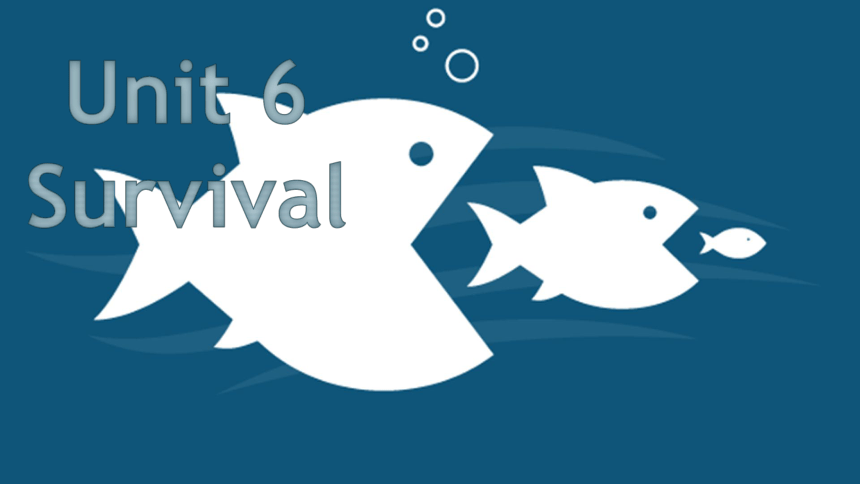 | |
| 格式 | pptx | ||
| 文件大小 | 25.4MB | ||
| 资源类型 | 教案 | ||
| 版本资源 | 外研版(2019) | ||
| 科目 | 英语 | ||
| 更新时间 | 2023-10-26 16:41:05 | ||
图片预览

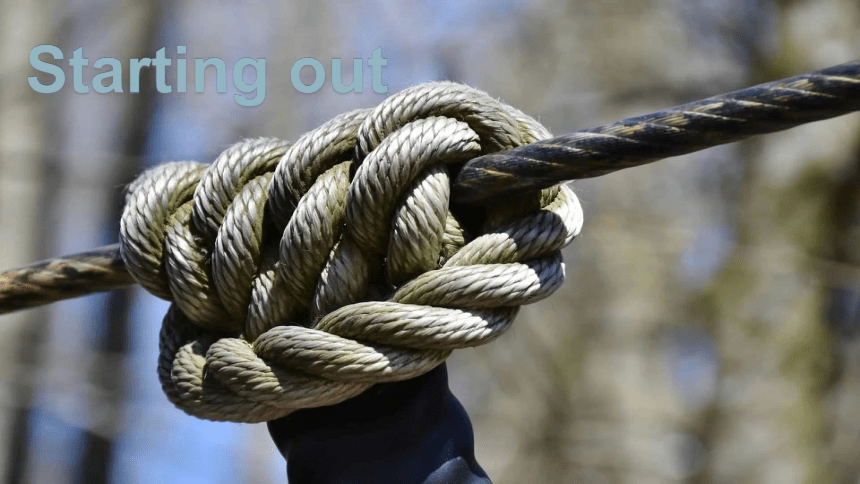
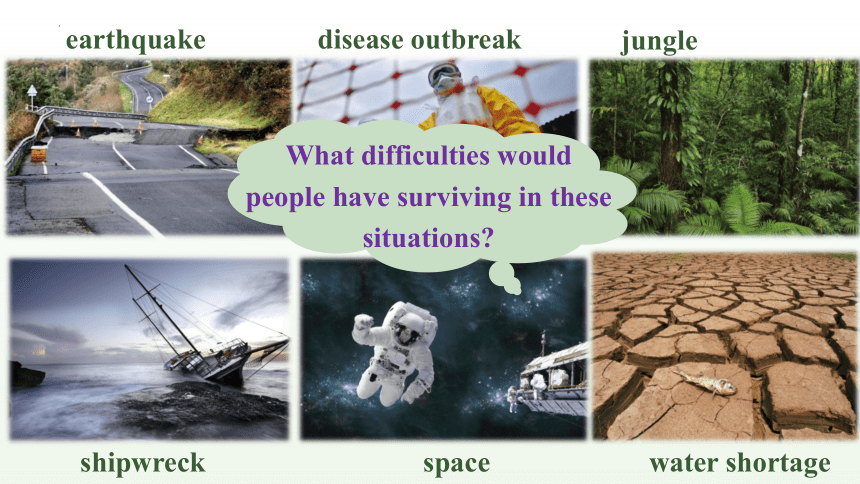


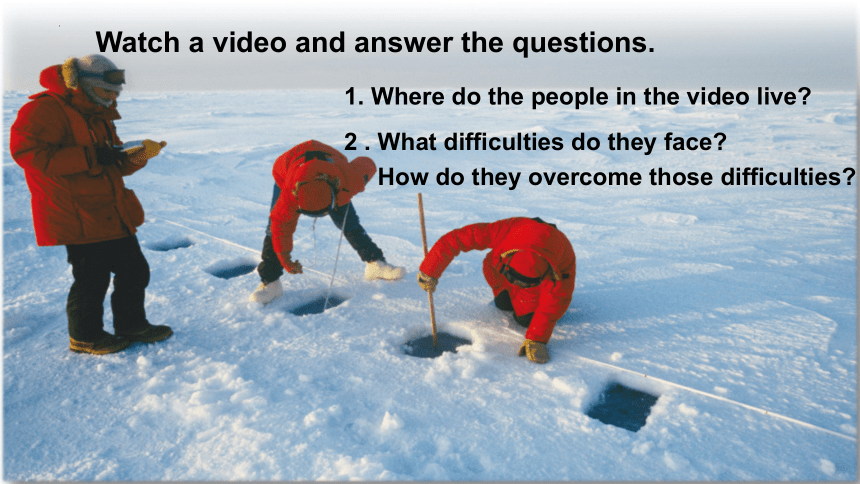

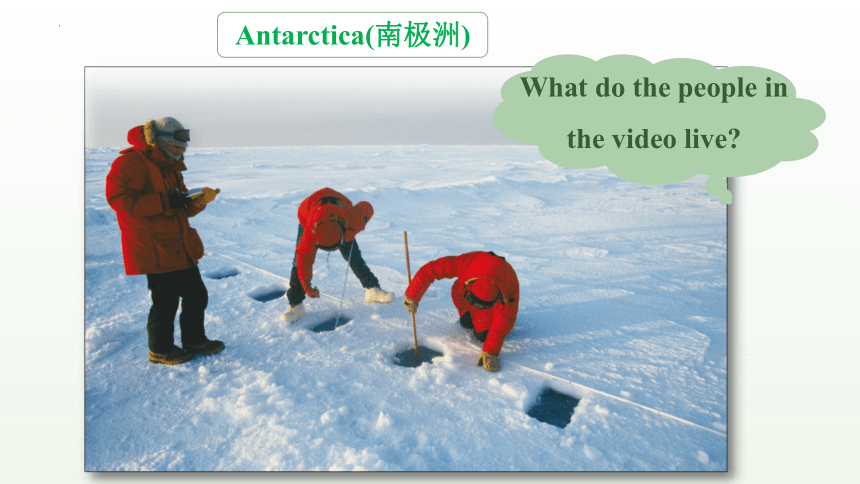

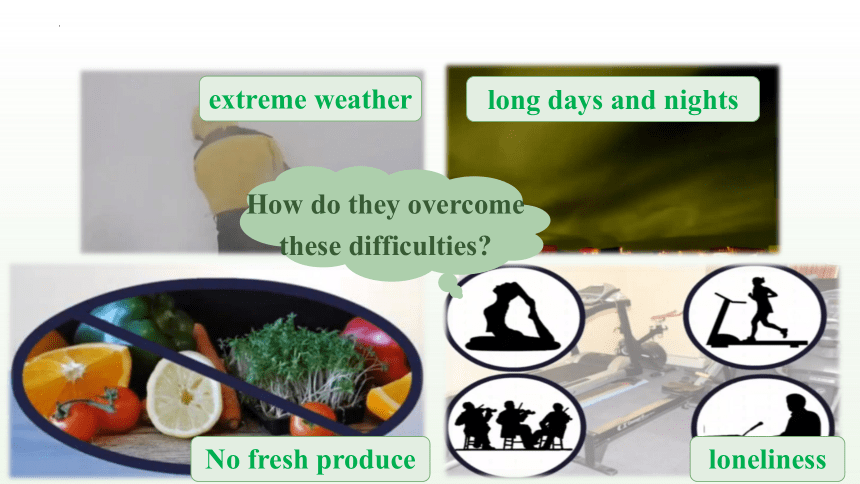
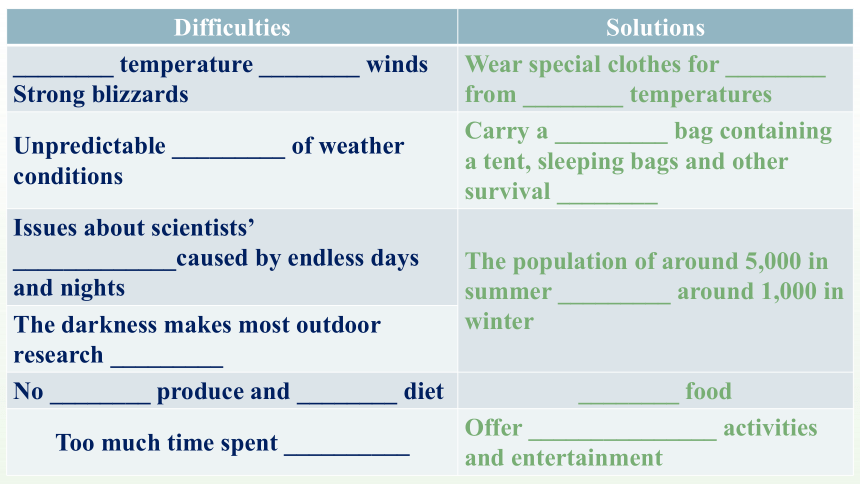
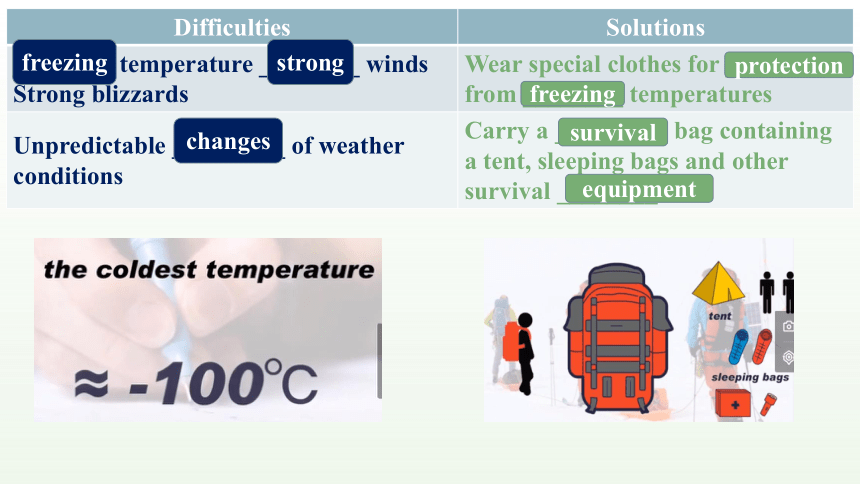
文档简介
(共39张PPT)
Unit 6 Survival
Starting out
earthquake
disease outbreak
jungle
shipwreck
space
water shortage
What difficulties would people have surviving in these situations
In an earthquake, ______________ (通信)and ________ (电力)may be cut off. If a disease breaks out, people will __________(恐慌) because of
misinformation (________) , quarantine (隔离) , lack of _________(必要的) supplies and __________(医药的) care. In a jungle, people find it extremely difficult to find ____________(方向). Besides, there are ____________(潜在的) dangers such as wild animals and venomous insects.
communication
power
错误消息
essential
medical
directions
panic
potential
earthquake
disease outbreak
jungle
If a shipwreck happens, people need to escape in _________(救生船) or they will die from drowning _____________(立刻). In space, astronauts will live in a zero-gravity environment, which make simple actions _________. Severe water shortage will result in _________ shortage which will cause _____________(迁徙), collapse of social order and war.
lifeboats
immediately
difficult
food
migration
shipwreck
space
water shortage
Watch a video and answer the questions.
1. Where do the people in the video live
2 . What difficulties do they face
How do they overcome those difficulties
What do the people in the video live
Antarctica(南极洲)
What is Antarctica like
It is the ______________, _______, _______, __________ continent.
southernmost
coldest
driest
windiest
Why do scientists live in Antarctica
Scientists expect to make new __________ by studying its unique ____________, _________ and _____________
discoveries
geography
geology
biodiversity
What difficulties do they face
extreme weather
long days and nights
No fresh produce
loneliness
How do they overcome these difficulties
标题栏文本
Difficulties Solutions
________ temperature ________ winds Strong blizzards Wear special clothes for ________ from ________ temperatures
Unpredictable _________ of weather conditions Carry a _________ bag containing a tent, sleeping bags and other survival ________
Issues about scientists’ _____________caused by endless days and nights The population of around 5,000 in summer _________ around 1,000 in winter
The darkness makes most outdoor research _________
No ________ produce and ________ diet ________ food
Too much time spent __________ Offer _______________ activities and entertainment
标题栏文本
Difficulties Solutions
________ temperature ________ winds Strong blizzards Wear special clothes for ________ from ________ temperatures
Unpredictable _________ of weather conditions Carry a _________ bag containing a tent, sleeping bags and other survival ________
freezing
strong
protection
freezing
changes
survival
equipment
标题栏文本
Difficulties Solutions
________ temperature ________ winds Strong blizzards Wear special clothes for ________ from ________ temperatures
Unpredictable _________ of weather conditions Carry a _________ bag containing a tent, sleeping bags and other survival ________
Issues about scientists’ _____________caused by endless days and nights The population of around 5,000 in summer _________ around 1,000 in winter
The darkness makes most outdoor research _________
No ________ produce and ________ diet ________ food
Too much time spent __________ Offer _______________ activities and entertainment
body clocks
impossible
falls to
fresh
varied
import
indoors
a variety of
freezing
strong
protection
freezing
changes
survival
equipment
Understanding ideas
The
Wild
Within
fox
leopard
bear
racoon
Where would you normally expect to find them
woodland
grassland
wetland
forests
mountains…
The wild are expected to be in the wild.
chacma baboon
hedgehog
Where are the wild
rubbish bins
high-rise buildings
street lamp
The wild are within the city.
Why do they live in the city
What challenges
would they meet
The
Wild
Within
without shelter
being trapped
being killed
C. For those animals that don't adapt, the city can be a dangerous or even deadly place.
D. Yet, for its newest and wildest inhabitants, city can offer many benefits.
Reading for Outline
The crime took place in a sea suburb of Cape Town.
Para 2
Para 1
Para 3
Para 4
Para 5
Para 6
A. One thing crucial to the increasing number of "urban animals" is their ability to adapt.
B. People often wonder about the reasons behind this mass urban migration.
However they adapt to …, it’s important that we get a better understanding …and learn to appreciate…
suggestions
adaptation
reasons
benefits
dangers
crime
Para.2
Reasons
Para.3
Benefits
Para 4
Adaptation
Para 5
Dangers
Para 6
Suggestions
Para 1.
The crime
Introduction
Explanation
Conclusion
Exposition
The crime took place in a seaside suburb of Cape Town. Spotting the car with its window left open, the greedy thief didn’t hesitate. Within seconds, he had reached inside and run away with a bag of shopping. No matter how many crimes he committed, the police were powerless to arrest him. You see, this was no ordinary criminal: it was a chacma baboon. Once almost unheard of, scenes like this one in Cape Town are now common all over the world. With foxes in London, mountain lions in San Francisco and wild pigs in Hong Kong, it is almost as if our cities are being taken over by wild animals.
Para. 1
crime / phenomenon
a chacma baboon in Cape Town
a fox in London
a mountain lion in San Francisco
a wild pig in Hong Kong
1. Why did the author give the example of the crime
To introduce the topic.
To show how animals live in the city.
C. To give us some dangerous warnings.
D. To call on us to take care of the wild animals.
2. What figure of speech (修辞) is used in it What’s the advantage of it?
Personification.
Making the description more vivid so that it can attract readers’ attention.
_________________________________________________________________
Most of us would assume that urban development and climate change are responsible for pushing the animals out of their natural habitats. However true this is, we also need to consider that some of these so-called “urban animals” have never moved at all-it’s we humans who have moved into their territory. Wherever they go, animals find towns and cities in their way. With nowhere else to make their homes, they have no choice but to move in with us.
b. People often wonder about the reasons behind this mass urban migration.
Para. 2
reasons for migration
_______________________________________________________
As our cities become greener, they offer increasingly appealing spaces to animals looking for new habitats. Out of reach from many of their natural predators, these newcomers often flourish in their new city lives. Today, foxes can be seen all over London-one even being found living on the 72nd floor of the Shard building when it was under construction! What’s more, hungry animals are finding plenty to eat in our gardens and in the leftover we throw away.
d Yet, for its newest and wildest inhabitants, a city can offer many benefits.
Para. 3
benefits of cities for animals
_______________________________________________________
There is evidence that urban racoons are more intelligent than their wild cousins, as they frequently have to figure out difficult problems such as how to open rubbish bins and other containers which they would not find in the wild. Some animals have even changed their living habits to fit in with their new homes. Although naturally active at night, urban foxes come out in daylight if the reward is good enough. Their city location also means that they are getting a taste for the multicultural cuisine on offer from the garbage, such as hamburgers, lamb kebabs and even garlic bread!
a. One thing crucial to the increasing number of “urban animals” is their ability to adapt.
In this paragraph, what does the writer use to prove his opinion
A. examples B. statistics C. theories D. experiences
Para. 4
animals'adaptation to cities
_______________________________________________________
Unable to distinguish between blue sky and glass, birds crash into windows at speeds of about 50 kilometers per hour. Recent studies estimate that between 400 million and 1 million birds die from window impacts each year in the US alone. Shockingly, these deaths amount to around ten per cent of the total US bird population. Some species are more affected than others. One theory behind this is that these birds have yet to change their migratory routes that take them through cities with high-rise buildings.
c. For those animals that don’t adapt, the city can be a
dangerous or even deadly place.
Para. 5
dangers for some animals
We should learn to better understand and_____________our
wild neighbours, and look towards ____________________our urban habitats.
appreciate
harmoniously sharing
However they adapt to our ways of urban living, it’s important that we get a better understanding of and even learn to appreciate our wild neighbours. Only then can we look towards harmoniously sharing our urban habitats. Whatever the reasons behind these species entering our cities, one thing is for sure - as it’s often a means of their survival, they could be with us to stay.
suggestions / conclusion
Para. 6
More and more wild animals are entering cities.
Reasons :
Urban development and climate change push the animals _______________
______________
Benefits :
Appealing spaces as habitats
______________________________
______________________________
Adaptation :
Urban animals are more___________________________
______________________________
Dangers :
______________________________ _______________
______________________________
We should learn to better understand and appreciate our wild neighbors, and ________________________________________________________________
Organize information from the passage and complete the diagram.
Para 2 Reasons :
Urban development and climate change push the animals_________________________________________
2. _________________________________________________
__________________________________________________
_________________________________________________
__________________________________________________
out of their natural habitats.
…it’s we humans who have moved into their territory.
Wherever they go, animals find towns and cities in their way. With nowhere else to make their homes, they have no choice but to move in with us.
Para 3 Benefits :
1. Appealing spaces as habitats.
2.___________________________________________________________________________________ ____________.
3._________________________________________ ______________________________.
Out of reach from many of their natural predators, these newcomers often flourish in their new city lives
Hungry animals are finding plenty to eat in our gardens and in the leftovers we throw away
Para 4 Adaptation :
Urban animals are more ____________ _________________________________.
________________________________________________________________________
_________________________________.
intelligent
than their wild cousins
Some animals have even changed their living habits to fit in with their new homes
adapt to
Para 5 Dangers:
________________________________________________________________.
____________________________________________________________________________.
Some birds crash into windows because they are unable to distinguish between blue sky and glass
Some birds have yet to change their migratory routes that take them through cities with high-rise buildings
Para 6 Suggestions:
We should learn to better understand and appreciate our wild neighbors, and ____________________________________________________________________________.
look towards harmoniously sharing our urban habitats
look forward to
Make laws to protect the wild and their habitats /plan urban construction wisely /set up more natural habitats/ provide enough shelter and food / educate people…
Raise awareness of environmental protection/ obey the laws/ plant trees/ respect, care about and protect the animals…
What can we do to achieve a balance between the need for urban development and the protection of wild animals
Presenting ideas
1. Who is to blame for stealing a bag of shopping
A . a greedy thief B. an ordinary criminal
C. a chacma baboon D. a clever fox
2. Why has so many animals rushed into our cities
A. The human beings had cut down too many forests.
B. The human beings had moved into the territory of the animals.
C. The animals love the ways to live in cities.
D. The climate change had destroyed the way of living of animals.
3. How can we learn that urban racoons are more intelligent
A. They could open the rubbish bins easily.
B. They can find homes in the containers.
C. They become active at night.
D. They are familiar with the hamburgers.
4. Why do birds crash into windows
A. Because they fly too fast.
B. Because there are too many birds.
C. Because they have already changed their migratory routes.
D. Because they mistake glass for blue sky.
根据语境选择恰当的介词或副词填空。
1. It is almost as if our cities are being taken _____ by wild animals.
2. Most of us would assume that urban development and climate change are responsible ______ pushing the animals out of their natural habitats.
3. Shockingly, these deaths amount ______ around ten per cent of the total US bird population.
4. Today, foxes can be seen all over London-one even being found living on the 72nd floor of the Shard building when it was ______ construction!
over
for
to
under
5. They frequently have to figure ______ difficult problems such as how to open rubbish bins and other containers which they would not find in the wild.
6.Some animals have even changed their living habits to fit ______ with their new homes.
7. Their city location also means that they are getting a taste ______ the multicultural cuisine on offer from the garbage
8. However they adapt ______ our ways of urban living, it’s important that we get a better understanding ______ and even learn to appreciate our wild neighbours.
out
in
for
to
of
Unit 6 Survival
Starting out
earthquake
disease outbreak
jungle
shipwreck
space
water shortage
What difficulties would people have surviving in these situations
In an earthquake, ______________ (通信)and ________ (电力)may be cut off. If a disease breaks out, people will __________(恐慌) because of
misinformation (________) , quarantine (隔离) , lack of _________(必要的) supplies and __________(医药的) care. In a jungle, people find it extremely difficult to find ____________(方向). Besides, there are ____________(潜在的) dangers such as wild animals and venomous insects.
communication
power
错误消息
essential
medical
directions
panic
potential
earthquake
disease outbreak
jungle
If a shipwreck happens, people need to escape in _________(救生船) or they will die from drowning _____________(立刻). In space, astronauts will live in a zero-gravity environment, which make simple actions _________. Severe water shortage will result in _________ shortage which will cause _____________(迁徙), collapse of social order and war.
lifeboats
immediately
difficult
food
migration
shipwreck
space
water shortage
Watch a video and answer the questions.
1. Where do the people in the video live
2 . What difficulties do they face
How do they overcome those difficulties
What do the people in the video live
Antarctica(南极洲)
What is Antarctica like
It is the ______________, _______, _______, __________ continent.
southernmost
coldest
driest
windiest
Why do scientists live in Antarctica
Scientists expect to make new __________ by studying its unique ____________, _________ and _____________
discoveries
geography
geology
biodiversity
What difficulties do they face
extreme weather
long days and nights
No fresh produce
loneliness
How do they overcome these difficulties
标题栏文本
Difficulties Solutions
________ temperature ________ winds Strong blizzards Wear special clothes for ________ from ________ temperatures
Unpredictable _________ of weather conditions Carry a _________ bag containing a tent, sleeping bags and other survival ________
Issues about scientists’ _____________caused by endless days and nights The population of around 5,000 in summer _________ around 1,000 in winter
The darkness makes most outdoor research _________
No ________ produce and ________ diet ________ food
Too much time spent __________ Offer _______________ activities and entertainment
标题栏文本
Difficulties Solutions
________ temperature ________ winds Strong blizzards Wear special clothes for ________ from ________ temperatures
Unpredictable _________ of weather conditions Carry a _________ bag containing a tent, sleeping bags and other survival ________
freezing
strong
protection
freezing
changes
survival
equipment
标题栏文本
Difficulties Solutions
________ temperature ________ winds Strong blizzards Wear special clothes for ________ from ________ temperatures
Unpredictable _________ of weather conditions Carry a _________ bag containing a tent, sleeping bags and other survival ________
Issues about scientists’ _____________caused by endless days and nights The population of around 5,000 in summer _________ around 1,000 in winter
The darkness makes most outdoor research _________
No ________ produce and ________ diet ________ food
Too much time spent __________ Offer _______________ activities and entertainment
body clocks
impossible
falls to
fresh
varied
import
indoors
a variety of
freezing
strong
protection
freezing
changes
survival
equipment
Understanding ideas
The
Wild
Within
fox
leopard
bear
racoon
Where would you normally expect to find them
woodland
grassland
wetland
forests
mountains…
The wild are expected to be in the wild.
chacma baboon
hedgehog
Where are the wild
rubbish bins
high-rise buildings
street lamp
The wild are within the city.
Why do they live in the city
What challenges
would they meet
The
Wild
Within
without shelter
being trapped
being killed
C. For those animals that don't adapt, the city can be a dangerous or even deadly place.
D. Yet, for its newest and wildest inhabitants, city can offer many benefits.
Reading for Outline
The crime took place in a sea suburb of Cape Town.
Para 2
Para 1
Para 3
Para 4
Para 5
Para 6
A. One thing crucial to the increasing number of "urban animals" is their ability to adapt.
B. People often wonder about the reasons behind this mass urban migration.
However they adapt to …, it’s important that we get a better understanding …and learn to appreciate…
suggestions
adaptation
reasons
benefits
dangers
crime
Para.2
Reasons
Para.3
Benefits
Para 4
Adaptation
Para 5
Dangers
Para 6
Suggestions
Para 1.
The crime
Introduction
Explanation
Conclusion
Exposition
The crime took place in a seaside suburb of Cape Town. Spotting the car with its window left open, the greedy thief didn’t hesitate. Within seconds, he had reached inside and run away with a bag of shopping. No matter how many crimes he committed, the police were powerless to arrest him. You see, this was no ordinary criminal: it was a chacma baboon. Once almost unheard of, scenes like this one in Cape Town are now common all over the world. With foxes in London, mountain lions in San Francisco and wild pigs in Hong Kong, it is almost as if our cities are being taken over by wild animals.
Para. 1
crime / phenomenon
a chacma baboon in Cape Town
a fox in London
a mountain lion in San Francisco
a wild pig in Hong Kong
1. Why did the author give the example of the crime
To introduce the topic.
To show how animals live in the city.
C. To give us some dangerous warnings.
D. To call on us to take care of the wild animals.
2. What figure of speech (修辞) is used in it What’s the advantage of it?
Personification.
Making the description more vivid so that it can attract readers’ attention.
_________________________________________________________________
Most of us would assume that urban development and climate change are responsible for pushing the animals out of their natural habitats. However true this is, we also need to consider that some of these so-called “urban animals” have never moved at all-it’s we humans who have moved into their territory. Wherever they go, animals find towns and cities in their way. With nowhere else to make their homes, they have no choice but to move in with us.
b. People often wonder about the reasons behind this mass urban migration.
Para. 2
reasons for migration
_______________________________________________________
As our cities become greener, they offer increasingly appealing spaces to animals looking for new habitats. Out of reach from many of their natural predators, these newcomers often flourish in their new city lives. Today, foxes can be seen all over London-one even being found living on the 72nd floor of the Shard building when it was under construction! What’s more, hungry animals are finding plenty to eat in our gardens and in the leftover we throw away.
d Yet, for its newest and wildest inhabitants, a city can offer many benefits.
Para. 3
benefits of cities for animals
_______________________________________________________
There is evidence that urban racoons are more intelligent than their wild cousins, as they frequently have to figure out difficult problems such as how to open rubbish bins and other containers which they would not find in the wild. Some animals have even changed their living habits to fit in with their new homes. Although naturally active at night, urban foxes come out in daylight if the reward is good enough. Their city location also means that they are getting a taste for the multicultural cuisine on offer from the garbage, such as hamburgers, lamb kebabs and even garlic bread!
a. One thing crucial to the increasing number of “urban animals” is their ability to adapt.
In this paragraph, what does the writer use to prove his opinion
A. examples B. statistics C. theories D. experiences
Para. 4
animals'adaptation to cities
_______________________________________________________
Unable to distinguish between blue sky and glass, birds crash into windows at speeds of about 50 kilometers per hour. Recent studies estimate that between 400 million and 1 million birds die from window impacts each year in the US alone. Shockingly, these deaths amount to around ten per cent of the total US bird population. Some species are more affected than others. One theory behind this is that these birds have yet to change their migratory routes that take them through cities with high-rise buildings.
c. For those animals that don’t adapt, the city can be a
dangerous or even deadly place.
Para. 5
dangers for some animals
We should learn to better understand and_____________our
wild neighbours, and look towards ____________________our urban habitats.
appreciate
harmoniously sharing
However they adapt to our ways of urban living, it’s important that we get a better understanding of and even learn to appreciate our wild neighbours. Only then can we look towards harmoniously sharing our urban habitats. Whatever the reasons behind these species entering our cities, one thing is for sure - as it’s often a means of their survival, they could be with us to stay.
suggestions / conclusion
Para. 6
More and more wild animals are entering cities.
Reasons :
Urban development and climate change push the animals _______________
______________
Benefits :
Appealing spaces as habitats
______________________________
______________________________
Adaptation :
Urban animals are more___________________________
______________________________
Dangers :
______________________________ _______________
______________________________
We should learn to better understand and appreciate our wild neighbors, and ________________________________________________________________
Organize information from the passage and complete the diagram.
Para 2 Reasons :
Urban development and climate change push the animals_________________________________________
2. _________________________________________________
__________________________________________________
_________________________________________________
__________________________________________________
out of their natural habitats.
…it’s we humans who have moved into their territory.
Wherever they go, animals find towns and cities in their way. With nowhere else to make their homes, they have no choice but to move in with us.
Para 3 Benefits :
1. Appealing spaces as habitats.
2.___________________________________________________________________________________ ____________.
3._________________________________________ ______________________________.
Out of reach from many of their natural predators, these newcomers often flourish in their new city lives
Hungry animals are finding plenty to eat in our gardens and in the leftovers we throw away
Para 4 Adaptation :
Urban animals are more ____________ _________________________________.
________________________________________________________________________
_________________________________.
intelligent
than their wild cousins
Some animals have even changed their living habits to fit in with their new homes
adapt to
Para 5 Dangers:
________________________________________________________________.
____________________________________________________________________________.
Some birds crash into windows because they are unable to distinguish between blue sky and glass
Some birds have yet to change their migratory routes that take them through cities with high-rise buildings
Para 6 Suggestions:
We should learn to better understand and appreciate our wild neighbors, and ____________________________________________________________________________.
look towards harmoniously sharing our urban habitats
look forward to
Make laws to protect the wild and their habitats /plan urban construction wisely /set up more natural habitats/ provide enough shelter and food / educate people…
Raise awareness of environmental protection/ obey the laws/ plant trees/ respect, care about and protect the animals…
What can we do to achieve a balance between the need for urban development and the protection of wild animals
Presenting ideas
1. Who is to blame for stealing a bag of shopping
A . a greedy thief B. an ordinary criminal
C. a chacma baboon D. a clever fox
2. Why has so many animals rushed into our cities
A. The human beings had cut down too many forests.
B. The human beings had moved into the territory of the animals.
C. The animals love the ways to live in cities.
D. The climate change had destroyed the way of living of animals.
3. How can we learn that urban racoons are more intelligent
A. They could open the rubbish bins easily.
B. They can find homes in the containers.
C. They become active at night.
D. They are familiar with the hamburgers.
4. Why do birds crash into windows
A. Because they fly too fast.
B. Because there are too many birds.
C. Because they have already changed their migratory routes.
D. Because they mistake glass for blue sky.
根据语境选择恰当的介词或副词填空。
1. It is almost as if our cities are being taken _____ by wild animals.
2. Most of us would assume that urban development and climate change are responsible ______ pushing the animals out of their natural habitats.
3. Shockingly, these deaths amount ______ around ten per cent of the total US bird population.
4. Today, foxes can be seen all over London-one even being found living on the 72nd floor of the Shard building when it was ______ construction!
over
for
to
under
5. They frequently have to figure ______ difficult problems such as how to open rubbish bins and other containers which they would not find in the wild.
6.Some animals have even changed their living habits to fit ______ with their new homes.
7. Their city location also means that they are getting a taste ______ the multicultural cuisine on offer from the garbage
8. However they adapt ______ our ways of urban living, it’s important that we get a better understanding ______ and even learn to appreciate our wild neighbours.
out
in
for
to
of
